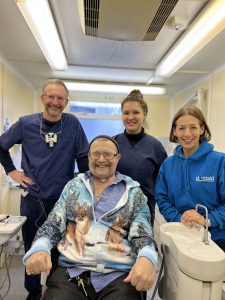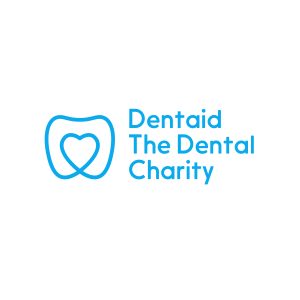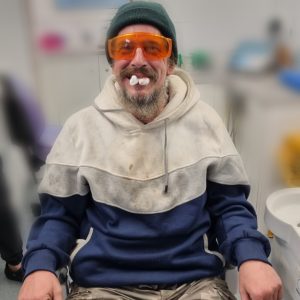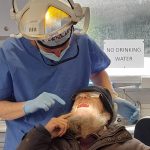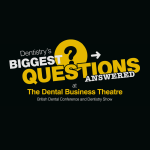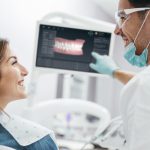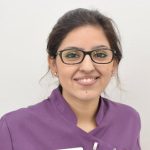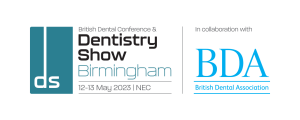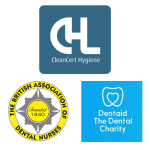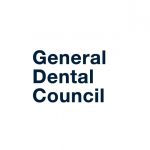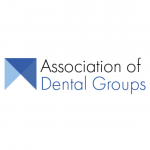Brian Bourke, non executive director from Dentists’ Provident, reviews the aetiology, diagnosis and management of missing teeth in this article, an abridged version of which appears in CPD 4 DCPs Volume 16
A tooth or teeth may be absent from the mouth for several reasons:
- Extraction or traum
- Tooth agenesis
- Failure to erupt into the mouth
When a tooth is missing following extraction, the cosmetic effect of the space, the impact of the space upon the other teeth in the dental arch and upon the occlusion may, individually or in combination, lead to a desire for orthodontic treatment. A space may be accepted, closed by orthodontic treatment or filled by a dental prosthesis. Such a prosthesis may be soft tissue-, dentally- or implant-borne.
Examples of such prostheses in order include: an acrylic partial denture, a resin-bonded bridge and an implant crown or bridge. Depending upon the age of a patient at the time of extraction, it may be appropriate to close a space if orthodontic treatment is required for other reasons such as moderate to severe dental crowding or dental centreline issues. Balancing (contralateral side of the dental arch) and compensating (opposing dental arch) extractions, however, may then be required in order to treat to a symmetrical outcome with a satisfactory occlusion.
Failure to note the absence of a tooth in the mouth at examination can lead to undesirable clinical consequences, especially where the tooth is present but unerupted. At any dental examination, it is important to count the teeth present carefully and to note any dental unit which is absent. If a tooth, other than a third molar, is missing but has not been extracted, or naturally exfoliated in the case of a child presenting with deciduous teeth, then it is either congenitally absent or unerupted.
Presentation of a missing tooth
Depending upon the age of the patient, it may be that the tooth is present and delayed in eruption, so there may be no cause for concern, unless this delay is significant. A significant delay indicating further investigation is where a tooth is absent from the mouth and 6 months have passed since the eruption of the contralateral tooth.
If a tooth is missing due to a failure in development, the condition is referred to as hypodontia. The condition may be further classified as:
- Hypodontia – 1 to 5 teeth absent
- Oligodontia – 6 or more teeth absent excluding third molars
- Anodontia – complete absence of teeth
Failure of a tooth to develop may be due to environmental or genetic factors. Environmental factors are those which have a negative impact upon early tooth development by physical or chemical means such as trauma, high dose irradiation, drugs such as trans-placental Thalomide and endocrine disturbances such as Hypoparatharoidism and Pseudohypoparathyroidism.
Genetic factors include Idiopathic Hypodontia, which can have a family history and conditions such as Ectodermal Dysplasia, Cleft Lip and Palate and Downs Syndrome1. Mutations in a number of genes including MSX1, PAX9 and EDA are commonly involved in hypodontia of genetic aetiology2. The teeth which are most frequently congenitally missing are those which are most distal in their series in the dental arch, namely: the lateral incisor, the second premolar and the third molar3. When third molars are included, up to 20% of the population are missing one or more teeth; when third molars are excluded, this percentage drops to approximately 5% of the population.
Hypodontia in the deciduous or primary dentition is relatively rare, occurring in 0.5%-0.9% of children4. When a deciduous tooth is congenitally absent, however, the successor tooth of the permanent dentition will also be absent. This is thought to be due to the development of permanent incisors, canines and premolars arising from a tooth bud that forms through further proliferation of cells on the lingual aspect of the deciduous tooth germ proliferating from the embryological dental lamina5. Consequently if the deciduous tooth germ fails to develop into a tooth, the permanent successor will also be absent.
The negative consequences of hypodontia are multiple including size and shape anomalies in the teeth which are present such as peg-shaped lateral incisors, enamel hypoplasia, spacing and occlusal discrepancies such as deep overbite, due to a lack of posterior occlusal support and occasionally due to the microdont nature of the incisors, which can occasionally accompany hypodontia. The cosmetic impacts of hypodontia upon psychosocial development can be significant.
Tooth eruption failure
The third principal reason for a missing tooth or teeth is through eruption failure: in other words, the tooth has developed but has failed to erupt into the mouth. Causes of eruption failure include:
- Dental crowding
- Ectopic development
- Physical obstruction
- Abnormal physical development
- Primary Failure of Eruption
Dental crowding can precipitate a situation where a tooth which erupts at a later stage, such as a permanent canine, has insufficient space available in the dental arch due to encroachment of the earlier erupted lateral incisor and possibly the first premolar, into the canine space. This can be exacerbated by premature exfoliation of the deciduous canine, thus facilitating this encroachment with accompanying drifting of the dental centreline between the central incisors to the affected side. The permanent canine will usually be evident as a bulge in the buccal sulcus or under the buccal attached gingival tissues. In most such occasions, the permanent canine will erupt into a buccally crowded position but in a minority of cases, the permanent canine will become impacted in the line of the arch and will fail to erupt.
Ectopic development, or more usually, an ectopic path of eruption is frequently associated with palatal impaction and eruption failure in maxillary permanent canines. Impaction or ectopic eruption of the permanent maxillary canine occurs in approximately 1-2% of the general population6 with palatally ectopic canines occurring with twice the frequency of buccally ectopic canines7. The maxillary permanent canine should be identifiable as a bulge high in the maxillary buccal sulcus in a child aged 9-10 years. If there is an asymmetry in the presence of this buccal sulcus bulge, or if neither canine is palpable by 10-11 years, then further investigation is indicated8.
A radiograph such as an Orthopantomograph or Dental Pantomograph will illustrate the teeth that are present and give some information as to the location of any unerupted teeth. This radiograph alone, however, will not usually be sufficient to locate the position of the ectopic maxillary canine should this tooth not be palpable buccally. It should also be remembered that a severely ectopic tooth may fall outside the focal trough of a dental tomograph and thus be overlooked. In order to locate the position of an ectopic canine with 2-dimensional radiographic imaging, it is usual to expose two intraoral radiographs, such as periapical views, of the canine applying a Horizontal Parallax technique. This involves exposing two radiographs of the maxillary canine region from two different directions of source of the X-ray beam, or, alternatively, an OPT and an intraoral periapical radiograph with camera angle shift. Vertical parallax can also be employed using an intraoral periapical radiograph or occlusal radiograph and an OPT.
It is desirable to have as large an angular shift in the horizontal (or vertical) plane as possible when carrying out this technique. When the two radiographs of the unerupted maxillary canine are compared, the change in position of the unerupted canine relative to the erupted adjacent teeth will indicate where the canine lies bucco-lingually. When using the horizontal parallax technique, the object which is further away from the source of the X-rays, in this case, a palatally ectopic canine, appears to move in the same direction as the X-ray camera source when the two x-ray images are compared. If the canine appears to move in the opposite direction to the X-ray source, then the canine is buccal to the dental arch.
The acronym SLOB (Same – Lingual(palatal), Opposite – Buccal) is helpful in remembering how to apply the parallax technique. If there is no shift in position of the canine, this indicates that the canine lies in the line of the dental arch9. In the great majority of cases, this technique will be sufficient to establish the location of the unerupted canine. There are occasions, however, such as when the unerupted ectopic canine has caused some root resorption of the upper lateral or central incisor, where a three dimensional image like a Small Field of View (FOV) Cone Beam CT (CBCT) scan will provide further information which may guide the management of the case. In cases of moderate to severe incisor resorption, the damaged tooth may have to be extracted and in such a situation, it is usually desirable to preserve the canine if possible and to incorporate it into the dental arch.
Physical obstruction of the path of eruption of a tooth can cause eruption failure. Examples of this include the presence of supernumerary teeth impeding the eruption of underlying teeth, as in the case of an upper midline supernumerary tooth and an unerupted upper central incisor. Multiple unerupted teeth associated with overlying supernumeraries is a classic feature of Cleidocranial Dysostosis. The presence of local pathology such as an odontome, a cyst or a tumour can also impede the eruption of a tooth. The surgical removal of the impeding object will usually allow the unerupted tooth to erupt, but in some cases assisted eruption with orthodontics is required.
Abnormal physical development can cause failure of eruption when the root of the tooth has been harmed or distorted during its pre-eruption development. Severe root dilaceration, where trauma on a developing permanent tooth germ through an impact in early childhood that caused intrusion of the deciduous tooth overlying it, can cause malformation in the root of the permanent tooth. This is most frequently seen in the roots of permanent maxillary incisors and can often lead to a distortion or dilaceration in the root of the affected incisor by up to 90o, which in most instances prevents eruption of the dilacerated incisor.
Primary Failure of Eruption is a rare condition with a prevalence of 0.06%10. It can affect deciduous or permanent teeth but is more common in the permanent dentition. It is most frequently observed in molars and premolars and all teeth distal to the most medially affected tooth tend to be affected11. Affected teeth may exhibit complete or partial failure to erupt and are prone to ankylosis.
Management
The management of a space in the dental arch will normally involve one of the following options:
- Accept
- Orthodontic space closure
- Orthodontic alignment of the unerupted tooth/teeth
- Autotransplantation
- Prosthetic replacement of the missing tooth or teeth
Accepting a space or gap may be the preferred option for a patient who is not interested in active treatment, cannot access orthodontic or restorative dental care, has poor oral hygiene or has health problems which contraindicate complex orthodontic or restorative dental care. The space of a missing tooth in the posterior region of the mouth may not present a significant cosmetic or functional problem for the patient and they may be content to live with the space. It is important, however, to inform the patient: of the risks of leaving an unerupted tooth in situ, of further tooth movement of adjacent teeth into the space and of the possibility of over-eruption of an opposing tooth if it is not in occlusion.
If a tooth is absent from the mouth, it may be feasible to close the space as part of an orthodontic treatment plan. This may involve extractions, e.g. of premolar teeth, in other quadrants, if there is significant dental crowding present and subject to the nature of the patient’s occlusion. If an upper lateral incisor is congenitally absent, there is usually a choice to be made as to optimising the size of the space with orthodontic treatment in order to facilitate prosthetic replacement of the missing incisor or closing the space with modification of the permanent canine to mimic the missing lateral incisor. The nature of the presenting malocclusion and the position of the upper dental centreline, the size, colour and shape of the permanent canines and their suitability to mimic one or both lateral incisors and the size and shape of the first premolars and their suitability to take the place of the maxillary canine are some of the factors which must be examined before finalising a treatment plan. The advantage in closing the space of an upper lateral incisor is that it avoids the need for prosthetic dental treatment and aftercare for the rest of the patient’s life with its associated financial and time costs.
Orthodontic alignment of unerupted teeth following their surgical exposure is often a treatment option of choice for ectopic unerupted maximally canines. This treatment is not exclusively carried out for canines, however, as many favourably positioned unerupted teeth should be amenable to orthodontic extrusion and alignment in the absence of major contraindications such as poor oral hygiene or poor general health. When a maxillary canine is ectopic and unerupted, the age of the patient will be a determinant in how best the case is managed. Children from the age of 8 years should be assessed at their routine dental examinations to confirm that the maxillary permanent canine can be palpated as a bulge in the buccal sulcus. If it is not palpable by age 10 years, then further investigation is indicated8. In specifically selected cases, a palatally ectopic maxillary canine will improve in position following the extraction of the deciduous canine precursor. If the permanent canine is going to respond favourably, it usually does so within a year of the primary tooth extraction. A general dental practitioner should seek the advice of a specialist in orthodontics or consultant orthodontist colleague before proceeding with such an intervention.
In the event that the maxillary permanent canine fails to erupt, it must be assessed in terms of its suitability for surgical exposure and orthodontic alignment. Factors such as the location of the ectopic tooth must be established. It is important to note the distance of the ectopic canine from its target position in the dental arch in terms of: height relative to adjacent roots, mesio-distal position and angulation to the occlusal plane. It is also important to examine for root resorption affecting the roots of adjacent teeth due to proximity of the canine crown or pathological activity of an enlarged dental follicle or follicular cyst associated with the canine. The options for an ectopic canine are: to accept its position with appropriate monitoring, surgical extraction or accommodation of the tooth in the dental arch, which usually requires surgical exposure and orthodontic alignment. Historically, transplantation of the canine following its surgical removal into a surgically prepared socket in the dental arch was occasionally attempted but most of these cases resulted in failure and loss of the tooth, usually due to resorption of the root.
Where a tooth has been lost due to trauma, such as the traumatic avulsion of an upper central incisor, the option of autotransplantation of the lower first premolar may be considered. A high success rate is associated with this approach if it is carried out in the 10–14-year-old age group before apical development of the lower first premolar root has completed to closure12.
A missing tooth space can be filled by a dental prosthesis. This may be removable, as in a partial denture which may be soft tissue borne (usually acrylic partial denture) or a combination of dentally borne and soft tissue borne (Cobalt Chromium partial denture). A prosthetic replacement for a missing tooth may be fixed in the form of a bridge (adhesive or full coverage) or implant borne.
Dental implants have become a popular choice for replacing missing teeth for many patients in recent years but for a successful long-term outcome, careful planning and execution and effective oral hygiene measures are essential. Smoking is a particular problem for the long-term survival of dental implants due to the negative effects of smoking upon the periodontal tissues and upon vascular health in the bone around an implant. There is some evidence that ongoing growth in the vertical dimension throughout adult life can cause cosmetic problems with relative intrusion of an anterior implant borne crown compared to the adjacent teeth13. This is particularly a matter of risk when an implant is fitted in later teenage years or in the early twenties, before vertical facial growth slows to its long-term adult rate, especially in patients with long faces and high maxillo-mandibular planes angles.
The appropriate management of missing teeth requires careful and timely investigation and, as such, it is usually in the primary dental care setting where this condition is first noticed and where the processes of diagnosis and treatment begins.
About the Author

Brian Bourke is a retired specialist in orthodontics, based in Cheltenham and a non-executive director of Dentists’ Provident, a leading provider of income protection insurance to the dental profession.
He has been an examiner for Fellowship of the Faculty of Dentistry of the Royal College of Surgeons in Ireland in orthodontics since 2011. He has previously been a Consultant Orthodontist and Head of Department at St. Columcille’s Hospital in Dublin, Chairman of the Orthodontic Advisory Committee of the Royal College of Surgeons in Ireland, member of the Specialty Advisory Committee in Orthodontics of the Royal College of Surgeons of England and Chairman of the Gloucestershire Orthodontic Managed Clinical Network.
References
- Al Shahrani I, Togoo RA, Al Qarni MA. A review of hypodontia: classification, prevalence, etiology, associated anomalies, clinical implications and treatment options. World J Dent 2013;4:117–25. 10.5005/jp-journals-10015-1216
- Cobourne MT. Familial human hypodontia—is it all in the genes? Br Dent J 2007;203:203–8. 10.1038/bdj.2007.732
- Jorgenson RJ. Clinician’s view of hypodontia. J Am Dent Assoc. 1980;101:283–286.
- Mehta V and Singh RK, https://www.ncbi.nlm.nih.gov/pmc/articles/PMC5073584/ – Congenitally missing primary and permanent maxillary lateral incisors
- Maria Hovorakova, Herve Lesot, Miroslav Peterka and Renata Peterkova. Early development of the human dentition revisited. J Anat. 2018 Aug; 233(2): 135–145. Published online 2018 May 10. doi: 10.1111/joa.12825
- Fleming P, Scott P, Heidari N, Dibiase A. Influence of radiographic position of ectopic canines on the duration of orthodontic treatment. Angle Orthod. 2009;79:442–6.
- Cooke J, Wang HL. Canine impactions: Incidence and management. Int J Periodontics Restorative Dent. 2006;26:483–91.
- Husain J, Burden D, McSherry P, Hania M. Management of the Palatally Ectopic Maxillary Canine. https://www.rcseng.ac.uk/dental-faculties/fds/publications-guidelines/clinical-guidelines/
- Singh WS, Pallak A, Kumar JA and Rahul S. Localization of Impacted Maxillary Canine: Comparative Evaluation of Radiographic Techniques. Journal of Nepal Dental Association – JNDA. Vol 15, No.1, Jan-Jun 2015
- Baccetti T. Tooth anomalies associated with failure of eruption of first and second permanent molars. Am J Orthod Dentofac Orthop. 2000;118(6):608–610. doi: 10.1067/mod.2000.97938.
- Proffit WR, Vig KW. Primary failure of eruption: a possible cause of posterior open-bite. Am J Orthod. 1981;80:173–190. doi: 10.1016/0002-9416(81)90217-7.
- Stange KM, Lindsten R and Bjerklin K. European Journal of Orthodontics, Volume 38, Issue 5, October 2016, Pages 508–515, https://doi.org/10.1093/ejo/cjv078
- Anna Klinge, Sofia Tranaeus, Jonas Becktor, Nicole Winitsky & Aron Naimi- Akbar (2021) The risk for infraposition of dental implants and ankylosed teeth in the anterior maxilla related to craniofacial growth, a systematic review, Acta Odontologica Scandinavica, 79:1, 59-68, DOI: 10.1080/00016357.2020.1807046
